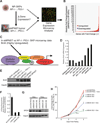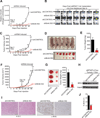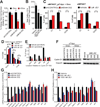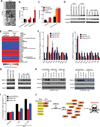BET bromodomain inhibition triggers apoptosis of NF1-associated malignant peripheral nerve sheath tumors through Bim induction
- PMID: 24373973
- PMCID: PMC3904298
- DOI: 10.1016/j.celrep.2013.12.001
BET bromodomain inhibition triggers apoptosis of NF1-associated malignant peripheral nerve sheath tumors through Bim induction
Abstract
Malignant peripheral nerve sheath tumors (MPNSTs) are highly aggressive sarcomas that develop sporadically or in neurofibromatosis type 1 (NF1) patients. There is no effective treatment for MPNSTs and they are typically fatal. To gain insights into MPNST pathogenesis, we utilized an MPNST mouse model that allowed us to study the evolution of these tumors at the transcriptome level. Strikingly, in MPNSTs we found upregulation of a chromatin regulator, Brd4, and show that BRD4 inhibition profoundly suppresses both growth and tumorigenesis. Our findings reveal roles for BET bromodomains in MPNST development and report a mechanism by which bromodomain inhibition induces apoptosis through induction of proapoptotic Bim, which may represent a paradigm shift in therapy for MPNST patients. Moreover, these findings indicate epigenetic mechanisms underlying the balance of anti- and proapoptotic molecules and that bromodomain inhibition can shift this balance in favor of cancer cell apoptosis.
Copyright © 2014 The Authors. Published by Elsevier Inc. All rights reserved.
Figures





Similar articles
-
Expression and inhibition of BRD4, EZH2 and TOP2A in neurofibromas and malignant peripheral nerve sheath tumors.PLoS One. 2017 Aug 15;12(8):e0183155. doi: 10.1371/journal.pone.0183155. eCollection 2017. PLoS One. 2017. PMID: 28813519 Free PMC article.
-
Overcoming BET Inhibitor Resistance in Malignant Peripheral Nerve Sheath Tumors.Clin Cancer Res. 2019 Jun 1;25(11):3404-3416. doi: 10.1158/1078-0432.CCR-18-2437. Epub 2019 Feb 22. Clin Cancer Res. 2019. PMID: 30796033 Free PMC article.
-
Dual mTORC1/2 inhibition induces anti-proliferative effect in NF1-associated plexiform neurofibroma and malignant peripheral nerve sheath tumor cells.Oncotarget. 2016 Jun 14;7(24):35753-35767. doi: 10.18632/oncotarget.7099. Oncotarget. 2016. PMID: 26840085 Free PMC article.
-
Tumor suppressor mutations and growth factor signaling in the pathogenesis of NF1-associated peripheral nerve sheath tumors: II. The role of dysregulated growth factor signaling.J Neuropathol Exp Neurol. 2005 Jan;64(1):1-9. doi: 10.1093/jnen/64.1.1. J Neuropathol Exp Neurol. 2005. PMID: 15715079 Review.
-
Toward Understanding the Mechanisms of Malignant Peripheral Nerve Sheath Tumor Development.Int J Mol Sci. 2021 Aug 10;22(16):8620. doi: 10.3390/ijms22168620. Int J Mol Sci. 2021. PMID: 34445326 Free PMC article. Review.
Cited by
-
HuR/ELAVL1 drives malignant peripheral nerve sheath tumor growth and metastasis.J Clin Invest. 2020 Jul 1;130(7):3848-3864. doi: 10.1172/JCI130379. J Clin Invest. 2020. PMID: 32315290 Free PMC article.
-
Bromodomain‑containing protein 4 is critical for the antiproliferative and pro‑apoptotic effects of gambogic acid in anaplastic thyroid cancer.Int J Mol Med. 2018 Jul;42(1):161-170. doi: 10.3892/ijmm.2018.3642. Epub 2018 Apr 26. Int J Mol Med. 2018. PMID: 29717765 Free PMC article.
-
Twist-BRD4 complex: potential drug target for basal-like breast cancer.Curr Pharm Des. 2015;21(10):1256-61. doi: 10.2174/1381612821666141211153853. Curr Pharm Des. 2015. PMID: 25506891 Free PMC article. Review.
-
BRD4 induces cell migration and invasion in HCC cells through MMP-2 and MMP-9 activation mediated by the Sonic hedgehog signaling pathway.Oncol Lett. 2015 Oct;10(4):2227-2232. doi: 10.3892/ol.2015.3570. Epub 2015 Aug 4. Oncol Lett. 2015. PMID: 26622824 Free PMC article.
-
A Novel Phenanthridionone Based Scaffold As a Potential Inhibitor of the BRD2 Bromodomain: Crystal Structure of the Complex.PLoS One. 2016 May 31;11(5):e0156344. doi: 10.1371/journal.pone.0156344. eCollection 2016. PLoS One. 2016. PMID: 27243809 Free PMC article.
References
-
- Albers AC, Gutmann DH. Gliomas in patients with neurofibromatosis type 1. Expert Review of Neurotherapeutics. 2009;9:535–539. - PubMed
-
- Albritton K, Rankin C, Coffin C, Ratner N, Budd G, Schuetze S, Randall R, Declue J, Borden E. Phase II study of erlotinib in metastatic or unresectable malignant peripheral nerve sheath tumors (MPNST) Journal of Clinical Oncology. 2006;24:9518.
-
- Bajenaru ML, Hernandez MR, Perry A, Zhu Y, Parada LF, Garbow JR, Gutmann DH. Optic Nerve Glioma in Mice Requires Astrocyte Nf1 Gene Inactivation and Nf1 Brain Heterozygosity. Cancer Research. 2003;63:8573–8577. - PubMed
-
- Biernaskie JA, McKenzie IA, Toma JG, Miller FD. Isolation of skin-derived precursors (SKPs) and differentiation and enrichment of their Schwann cell progeny. Nat Protocols. 2007;1:2803–2812. - PubMed
Publication types
MeSH terms
Substances
Associated data
- Actions
Grants and funding
LinkOut - more resources
Full Text Sources
Other Literature Sources
Molecular Biology Databases
Research Materials
Miscellaneous

